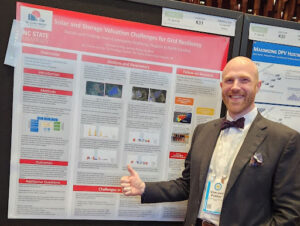Takeaways and Results from Photovoltaic Specialist Conference 2024
Vincent Potter, Senior Policy Analyst
I attended the IEEE Photovoltaic Specialist Conference (PVSC) 2024 in Seattle, WA from June 10 to 14, 2024. I spent four days in the lovely city, getting my horizons expanded by materials scientists, engineers, physicists, and other researchers. The Conference is divided into tracks that touch on various issue areas in solar energy research, ranging from the fundamentals of photovoltaics, to advanced chemistries and construction strategies for perovskites, to deployment and sustainability. The Conference attracted around 800 attendees from over 40 countries. Overall, it was a fantastic opportunity to see the cutting edge of solar research and new ideas!

I submitted an abstract to Track 11 (PV Deployment) to present on the Center’s work to improve access to solar for lower-income households by finding new benefits to reduce costs. While in Seattle, besides all of my learning, I saw some family and the city itself. According to my pedometer, I logged an average of 14,000 daily steps while I was there.
There were plenary sessions that highlighted research progress in thermal-photovoltaic heat engines (a potential method for industrial process decarbonization); custom instruments, construction methods, manufacturing processes, and metrology for new PV creation; and advances in weather tracking to improve solar output forecasts. Researchers also discussed grid integrations and modeling grid performance with high amounts of PV contributing power, as well as the role of solar PV in the transition to carbon-free electricity.

There were several special sessions at the conference. I attended the “100% RE” Session which asked how much Solar PV would be needed to support a net zero emission economy along with wind, battery storage, and other non-emitting energy sources. Worldwide, the estimates are around 75 terawatts (75,000,000 megawatts) to support the net-zero goal, about 1.5 to 3 terawatts would be needed in the US by 2050. This broad use of solar PV would require terawatts of annual installations. The 2023 annual market projection was about half of one terawatt.
That is not all! There were oral presentations and posters submitted for each of the issue areas. Many of which were thorough and detailed analyses of new processes that may have market-changing implications if they continue the show cost reductions in the way that silicon PV has over its lifetime. I presented my poster on Thursday evening and had a blast talking with passers-by and other PV Deployment poster presenters about getting solar panels into the field and maximizing overall benefits, as well as addressing problems on the fly, both in research and on the field. My poster was one of three nominees for best poster in its area. Ultimately, Preeti Nain from Michigan State took the ribbon for work on calculating a Carbon and Energy Payback Time on Residential Solar PV Repowering.
When not traveling for posters and presentations, Vincent Potter works on the Center’s Policy and Markets team. His specialties are grid engineering, interconnection, and community solar.